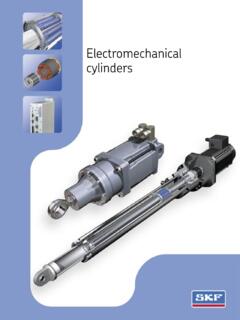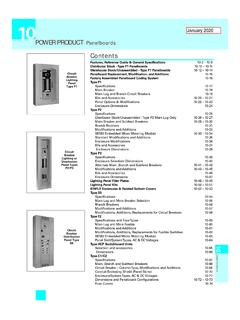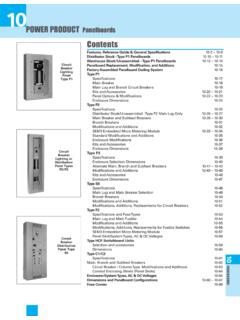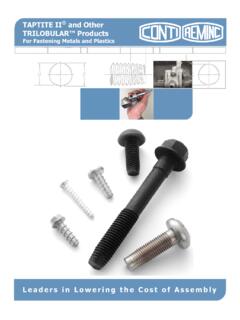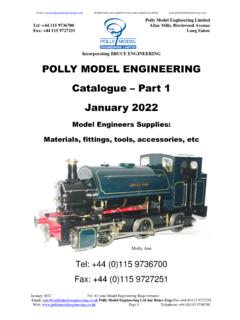Transcription of Matt Walker's 30 Ton Hydraulic Forging Press
1 Matt Walker's 30 Ton Hydraulic Forging Press by Matt Walker and Dave Smucker Back in February, Matt Walker sent me some pictures and notes on a new 30 Ton Hydraulic Forging Press that he had designed and constructed. I saved these for a possible article and then when we had the AACB Meeting in April at Bristol Forge at Rock Mount, Kit Wattenbarger and I had a chance to stop by Matt's shop and see his Press in action. Matt built this Press to forge damascus steel knife billets. Matt makes and sells damascus billets for knife making as one of his production Forging jobs. To start this article off and set the scene, in the next column is a series of dynamic photos showing Matt's Press squishing a 2-inch diameter x 6 inch bar the long ways.
2 Now, I have seen a lot of heavy industrial Forging 3,000 and 4,000 Ton presses in action on heavy open die forgings for rolling mill equipment. These huge presses do take heavy reductions on very large chunks of steel but it was still most impressive to see Matt's Press in operation. He could take a hot bar out of his gas forge and quickly upset the 6-inch piece lengthwise. It did buckle but the speed of Forging was impressive. Here is what Matt had says: Hello Dave, Here are some notes I promised you awhile back about my Forging Press . I've only had it up and running for a couple of months now and still haven't done much general forge work with it. However, I'm thoroughly impressed with what it will do.
3 I have been using it for mostly damascus steel production. It will easily move twice as much metal per heat as my 80-pound Kinyon Style Air Hammer Time at seconds Time at seconds Time at seconds Time at seconds Another big advantage for most types of work is that the dies can be changed in a matter of a few seconds. Also, I have found that when I am Forging to a specific size I only need to lay a stop block between the dies, unlike the need to secure stop blocks with a power hammer. I think this is a big help in pattern welded steel production or any operation for size because I find it is hard on a hammer designed to work hot steel to continually beat on cold stop blocks.
4 I had several failures in my rod to head connection on my air hammer from using stop blocks. Here we see Matt's lower die holder. On each side are some of his pattern tooling. Here is a basic die in the lower die holder. On each side are some slip on dies or tooling that just lay over the bottom die. For the top die a simple pin holds them in place My Press has 14 inches of movement and a 16-inch throat so there is little limitation to the tooling that I can use under it. I believe that most of the tooling that we have learned about from Clifton Ralph and Clay Spencer could be used in a Press easier, more accurately and safer. Here is an overall view of the Forging Press .
5 Cylinder is a 5 inch 3000 psi cylinder. The control valve is at the right while the Pump, Motor and Tank are located below the fixed lower die holder. While not fast and violent like a hammer blow in a power hammer, there is a tremendous amount of pressure that can kick out poorly positioned tools or work. Therefore, one needs to think very carefully about what he is doing and go slow until a move or tool has proven safe. Like a big hammer, you don't want to stand in the line of fire either. Design Considerations Speed is very important because the dies pull heat out of the work, even when pre-heated. I have found that what works for me is a two-stage pump rated at 13 gpm (gallons per minute).
6 I understand that as resistance builds, the flow from the pump falls to 25 percent but that the output pressure is 4 times as high . For my Press this translates into a inch per second top die movement until it meets resistance and then drops to inches per second in the hot metal. It seems to push bigger pieces of work like clay but will not make much of a showing per heat on thin work. (Under 1/4 inch). My pump arrangement requires a 6 horsepower motor. This view shows a close up of the Motor, Pump and Tank The 30 tons of force from my Press seems to do all that I could hope for. This is achieved from a 5-inch cylinder with the pump operating at 3000 psi (pounds per square inch).
7 I am not sure this much power is necessary. I have seen another Press running at 16 tons move an amazing amount of metal. It seems to me that the critical issue is to get the work done before the dies can chill the work piece. Once it turns black, you don't want to keep Forging because the work will be stressed and cracked. What is a 2-stage pump? Well these are not really true 2-Stage Pumps but that is what Northern Hydraulic and others have been calling them. They are really a 2-volume positive displacement pump with an internal unloading valve. The pump is built with 2 gear pumps common to the same shaft with one of the pumps 3 times the size of the other. At low resistance (back pressure) both pumps function and deliver the maximum flow.
8 When the resistance increases and the back pressure increases then the internal unloading valve shifts flow to just the smaller gear pump. It is now able to use the full horsepower of the motor to deliver the high pressure but at only 1/4 of the flow rate. These are good pumps for these simple applications and much lower cost than high performance variable volume pumps. In a true 2-Stage pump, the first stage would provide flow to the second stage that would then boost the pressure to the output level. You see this function in a 2-Stage air compressor, for example. Dave For the main control valve, I like a valve that goes to neutral center so that I can bring the space between the two just clear of whatever size the work happens to be.
9 Some valves automatically return the ram when released, but this requires a full stroke each time to get to the work. In addition, a valve that allows you to adjust the pressure is nice. My control valve is operated with a push pull cable connected to a foot pedal. I think foot pedal control is great because sometimes the work is pushed over the bottom die enough that a shoulder is formed requiring that the work is lifted in order to advance the piece. This is hard to do with one hand if the other hand is operating the valve. Don't misunderstand this comment this does not mean it is OK to put hands between the dies just that the use of both hands, well clear of the Press , are sometimes required to position the work.
10 I was told that the rule of thumb is that the oil reservoir should be 3 times the capacity of the pump. So far, I haven't found this to be true. I found a 20-gallon Hydraulic reservoir in a scrap yard and used it. This reservoir has a thermometer on the tank and so far, the fluid hasn't even gotten warm. While I have only used my Press in cooler weather, I believe the way a blacksmith will use the Press that a smaller oil reservoir would work fine. Editor note: Matt's tank only needs to be sized for the work being done at the high -pressure output of the pump. This would be 3 times gpm or a little less than 10 gallons so in fact his reservoir is about twice the size required.
